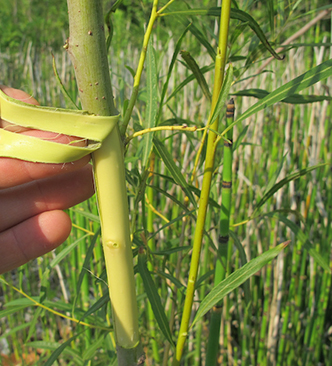
By Carrie Armstrong
Carrie Armstrong is from Michel First Nation in Alberta. She's a teacher, and the founder of Mother Earth Essentials. In 2020, Carrie published her book Mother Earth Plants for Health & Beauty: Indigenous Plants, Traditions and Recipes with Eschia Books. Carrie is reflective of her own teachings. There are many different teachings and variations.
As we welcome the arrival of spring, it's the perfect time to reconnect with nature and embrace the healing properties of willow bark. Luckily, we have plenty of places in our country where we can find willow trees. Personally, I'm a fan of white willow, and I've incorporated it into both my tea blends and facial products.
One of the amazing things about white willow is its abundance and accessibility. But what makes it truly special is its healing properties. Willow bark contains salicylic acid, which is a natural anti-inflammatory and astringent. When brewed as a tea, it works wonders for relieving aches, pains, and even arthritis.
But here's a cool tip: If you make a strong brew of white willow bark, you can also use it as a facial treatment. All you need to do is steep 3 tablespoons of white willow bark in 1 cup of purified boiling water for an hour. Then, using a cotton ball, gently apply the infusion to clean skin and let it sit for 5 or 10 minutes. Not only will this naturally brighten your skin by reducing fine lines and removing dead skin, but it will also help reduce inflammation, making it a fantastic acne treatment too.
So, whether you're looking for relief from aches and pains or want to give your skin a natural glow, willow bark is your go-to buddy. It's a wonderful way to harness the power of nature and enhance your wellbeing. Let's embrace the healing properties of willow bark and let Mother Earth work her magic!

Here's a step-by-step guide on how to harvest willow bark:
1. Look for young branches of willow during the spring season, just before the sap starts flowing. You'll notice that the branches have a vibrant new spring color, making them easy to identify.
2. To separate the bark from the branch, gently strip the bark off the young branches. This is the best time to do it because the bark is more pliable and easier to remove.
3. Once you've collected the willow bark, you have two options: you can use it fresh or dry it for later use.
4. If you choose to dry the bark, start by cutting it into thin strips that are less than 3 inches long. This will help with the drying process and make it easier to store.
5. There are a couple of methods you can use to dry the willow bark. You can either use a dehydrator or simply spread the bark strips on a baking sheet and leave them out on the counter for a few days. The goal is to remove the moisture from the bark until it becomes dry and brittle.
6. Once the bark is completely dry, you can store it in an airtight container to preserve its freshness and potency.
Now you know how to harvest and prepare willow bark for medicinal use. It's a great way to tap into the natural healing properties of this amazing plant. Always check with your medical professional before using our powerful plants. Willow is not safe if you are allergic or sensitive to aspirin.
Editor’s Note: As Carrie says, it’s important to be well informed about any plant medicine that you choose to use and how it will affect your own body. Do your own research.
When picking plants for your own use, please pick with care, ensuring you correctly identify the plant prior to use. Take only what you need. Break leaves, flowers, stems off gently as opposed to pulling out by roots.
Please be aware that you pick in a safe, chemical-free area and know that some plants can be toxic at certain times of year. Do not gather any endangered species of plants.
In some Indigenous cultures, tobacco is offered to Mother Earth as a way of showing gratitude for the medicines.
